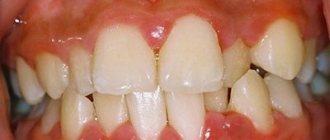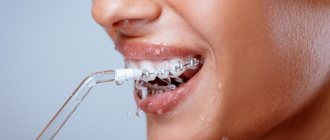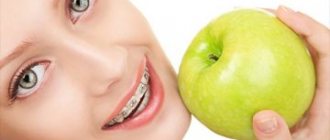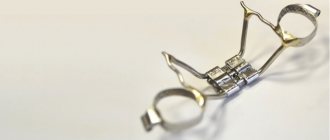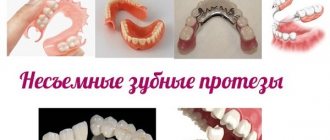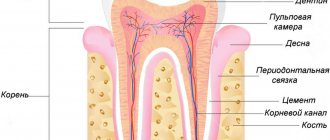Most often, the Patient is concerned about the issue of dental aesthetics, and if the problem at first glance is local in nature - only the upper or only the lower teeth are crooked, he wants to know whether it is possible to treat only one jaw with braces. This is quite natural - a person who has no knowledge of orthodontics quite sincerely does not understand why install a system on a “healthy” jaw and pay twice as much?
Often the Patient worries that in this way the clinic is trying to make more profit by imposing unnecessary treatment.
When deciding whether to install a system, the orthodontist is guided by the data obtained during the diagnosis and evaluates whether aligning the teeth in only one jaw can disrupt function or affect the stability of the final result. Does the Patient need such savings? Of course not.
If we turn to the very concept of bite, it becomes clear that it is the closure of two jaws. And it is not a fact that the straight teeth of one of them fit correctly with the dentition of the other and do not need correction.
What are braces?
Braces, or rather brace systems, are dental structures for eliminating malocclusions and problems with incorrect position of teeth.
Alignment with orthodontic braces began to be practiced back in 1776 in France, but the heavy structures used then interfered with speech and extended beyond the mouth. More than a hundred years later, the device was radically improved in America. Today, the classic system looks different and consists of three main elements: ➢
braces - clasps that are attached to the teeth
➢
orthodontic arch
➢
fastenings (ligatures) for coupling the arch with the clasps
What are crooked teeth and what is the diagnosis?
Patients call their teeth crooked for different diagnoses. They can often be corrected with braces. What are called curved units in dentistry are divided into groups of anomalies:
- Position of individual teeth.
- Defects in the shape of the dentition.
- Bite problems.
If the position of the front teeth is incorrect, it is immediately noticeable, and the person often turns to the dentist. Teeth may tilt, rotate, or move in different directions. Very often there is a combined malocclusion of the central and lateral groups of teeth simultaneously in the lower and upper jaws.
Main types of braces
Previously, when it was necessary to straighten with braces, for many patients the stopping factor was the aesthetic side of the issue - the structures were made exclusively of metal and were fixed on the outside of the teeth. Now there are many types of orthodontic systems to suit every taste. The main differences between braces are the installation methods and materials of manufacture.
External and internal braces
A frequent question from patients is whether it is possible to place braces on crooked teeth without others noticing. Internal, or lingual, braces allow you not to worry about the aesthetic aspect. Unlike external ones, lingual systems are fixed on the back of the teeth and are completely invisible to others. True, the patient takes longer to get used to the lingual system. But it is not always suitable for people with allergies, since it is made of metal, which can provoke an allergic reaction.
Ligature and non-ligature braces
Ligature and non-ligature systems differ in the method of attachment to the arch. The first ones are attached using clamps (ligatures), while the second ones are devices of a more advanced level that do not require additional fastenings. Ligature-free braces allow you to adjust the position of the arch once every 2-3 months. However, many specialists prefer monthly treatment monitoring. Despite their more advanced structure, it is difficult to say that non-ligature dental braces are more effective than traditional ones.
Diet restrictions
To prevent braces from breaking or changing the vector of force, you need to reconsider your diet. Orthodontists recommend:
- hard vegetables and fruits must be grated or crushed in a brander before use;
- You cannot bite seeds, chew gum, eat nuts, dried apricots and other dried fruits;
- Avoid consuming very hot or extremely cold foods and drinks;
- limit the intake of food and drinks containing artificial or natural colors (tea, coffee, red wine, soda, berries, etc.).
Important: failure to follow the recommendations given by a specialist may result in system failure. In this case, the device will need to be repaired, which will lead to an increase in the correction period and an increase in the cost of treatment.
Types of bracket systems
Some people don’t attach importance to the presence of a metal device in the mouth - back in the 90s, Cindy Crawford not only wore dental braces, but even starred in them in an advertising campaign for Pepsi Cola. For those who have chosen external orthodontic braces, but prefer not to advertise the treatment, there are other options.
Types of braces depending on material
- Plastic: the most budget braces - from 20,000 rubles. It is the plastic design that has become not just a device for dental treatment, but also an accessory that complements the image. Unfortunately, it also has many disadvantages: plastic is not the most durable material, in addition, such dental braces change color under the influence of coloring products.
- Metal: The most durable of all braces for straightening teeth, but they are not suitable for people with metal allergies. A steel system will cost 60,000 - 80,000 rubles, a titanium system - from 80,000 to 100,000 rubles. In terms of aesthetics, this is not the most advantageous design.
- Ceramic: highly aesthetic, matched to the color of the enamel, does not cause allergies, but is less durable than metal. In Moscow, the cost of ceramic braces is 40,000 - 70,000 rubles.
- Sapphire: the most aesthetic of all options. They look very impressive in the light, but if the patient’s teeth have a yellowish tint, you should carefully consider whether sapphire braces are needed, as they will stand out strongly. Also quite fragile. The cost of sapphire structures is 100,000 - 150,000 rubles.
How do braces differ from each other?
| Type of braces | Materials | Differences | Price |
| Metal | metal alloy | reliable and cheap | from 50,000 rubles* |
| Ceramic | ceramics | the most inexpensive of aesthetic | from 70,000 rubles* |
| Sapphire | artificial sapphire | beautiful and relatively inexpensive | from 100,000 rubles* |
| Lingual | gold + metal | completely invisible | From 150,000 rubles* |
*Prices are indicative in Moscow and only for the bracket system.
What are braces?
A brace system is a non-removable orthopedic device consisting of clasps with grooves (braces), an arch that combines these clasps into a single mechanism, additional elements - elastics, ligatures, and an arch is passed through the grooves. The principle of operation lies in the ability of a metal arc to take its original shape. Straightening up, she pulls the locks behind her, pulling the teeth into the required position. The result is stabilized with fixed or removable retention devices.
Bracket systems differ in design - they are ligature, self-ligating, vestibular, lingual. They are made from a variety of materials: metal alloys (including gold), polycrystalline ceramics, synthetic sapphires. Devices made of metal have no equal in strength; the most aesthetically pleasing are ceramic and sapphire. When choosing which is better, aligners or braces for straightening teeth, you take into account not only the aesthetic side. The main thing to start from is the capabilities of the system in a particular case.
How do braces straighten teeth?
It is designed by nature that our teeth can change position - independently or under the influence of external forces. Thanks to this property, orthodontic treatment with braces becomes possible. Its principle is the following.
- Based on the patient’s clinical picture, the doctor plans a trajectory of movement for each tooth; one bracket is responsible for one dental unit.
- During the process of fixing the braces, the clasps are connected to each other by an arch with shape memory, which it tends to take over time.
- Under the influence of the arc, the dentition begins to take the desired position.
- During treatment, the archwire is replaced with a more rigid one to increase the impact.
Design features of ligature braces
All bracket systems have the same design:
- bracket plates fixed to the teeth using a special adhesive composition;
- a power arc that has “shape memory” (tends to straighten out from a bent position);
- fastening elements that attach the arch to the bracket plates.
If the arch is fixed to the teeth using miniature clips, then such braces are called non-ligating or self-ligating braces. If the arch is attached using ligatures, then such orthodontic structures are called ligature. This is, as they say, a “classic of the genre.”
Either small plastic rings or thin metal wire made of medical steel are used as ligatures.
Plastic ligatures can be of various shades: transparent, silver, colored. Teenagers, as a rule, prefer rich colors. While wearing, the ligatures stretch, so the doctor periodically changes or tightens them.
Note: compliance with the prescribed frequency of visits to the clinic during the correction course is the key to the effectiveness of the process. Otherwise, the result may not be achieved.
Ligature braces are effective in treating both adults and adolescents.
Indications and contraindications for installation
Problems that alignment with braces can help solve:
- crooked teeth due to improper growth
- displacement of the dentition as a result of the removal of dental units
- jaw development disorder
When there is crowding and gaps between teeth, braces are the optimal solution. In the latter case, it will not be possible to manage with orthodontic treatment alone; complex procedures with the participation of a surgeon will be required.
When are braces installed?
- Bite disorders of any nature or complexity;
- crowded teeth;
- disproportion of jaws (one is less developed);
- dental anomalies;
- incorrect position of the dental unit (curvature, rotation around an axis);
- removal of an unerupted tooth;
- upcoming prosthetics, implantation.
Treatment with ligature devices will take 2.5-3 years
, self-ligating -
1.5-2 years
. The duration of the adjustment depends on the clinical features and system model.
At what age are braces placed?
The mobility of teeth in the jawbone persists throughout a person’s life, therefore, the answer to the question “Can braces be placed on crooked teeth in adulthood?” - positive. However, correcting a child’s bite with braces is much easier.
You can begin treatment as early as 9 years of age, even if not all baby teeth have been replaced by permanent teeth. The most optimal age for installing braces is 12 - 13 years old, but even at 30, braces will show good results. It will just take more time.
Classification
There are several types of irregularities in the shape of rows:
- Uniform narrowing. A visually elongated frontal segment is observed. The tight fit of the incisors to each other provokes a fan-shaped position.
- Clenched jaw. A saddle-shaped narrowing is formed in the area of molars and premolars. Reduced space in the jaw arch results in oral or buccal deviation of the masticatory units.
- Narrowing of the frontal zone. The arc has a V-shaped configuration. There is a tight fit to each other and anterior advancement of the incisors.
- Trapezoidal narrowing. The shape of the arc is similar to a trapezoid with 4 corners. Crowded incisors form a straight line. Lack of space leads to rotation of units.
- Uneven narrowing. Pathology is diagnosed in individual areas of the row and manifests itself in the form of crowding of units in a clearly defined area.
Braces for crowns, veneers, implants
Crowns are not a contraindication to orthodontic treatment. The best option for installing braces on crowns is a metal system. It will provide reliable adhesion to the artificial material of the prosthesis. If you need to install a brace system on the teeth that serve as support for the bridge, the doctor will simply remove the prosthesis and put temporary plastic crowns on the patient for the period of treatment.
As for veneers, if they are already on the teeth, this will not be a contraindication to installing a brace system. However, it is still better not to install veneers before braces, especially taking into account that an incorrect bite is, in principle, a contraindication to veneering.
With an implant, it is already more difficult to correct the bite with braces - the artificial root sits firmly in the bone and is not able to move except upward. If possible, it is better to correct the curvature of the dentition before installing an artificial root. However, if implants are already in place, orthodontic treatment can still be planned and successfully carried out.
Stages of corrective therapy
Correcting anomalies of the dental system is a long and painstaking process consisting of several stages:
- visual and hardware diagnostics: computed tomography, teleradiography,
- rendering a verdict, making a diagnosis, determining indications and contraindications;
- development of a treatment plan;
- oral hygiene: treatment of teeth and gums, professional cleaning;
- taking individual measurements (casts or scanning), making a model, drawing up an estimate;
- production of braces;
- installation of a brace system for a patient;
- wearing the device with periodic system adjustments. The duration depends on the severity of the specific clinical case and is determined by the orthodontist;
- removal of braces and installation of a removable or non-removable retainer. The duration of retention also depends on the individual characteristics of the clinical case.
Specialist comment: the retention stage is very important for consolidating the achieved results. Failure to follow the recommendations of the attending orthodontist may invalidate the results of therapy, and everything will return to its previous position.
Braces for extracted teeth
It is possible to install an orthodontic structure in the absence of one or more teeth, but it depends on the specific clinical picture. For example, it is quite possible to straighten a slight curvature in the frontal zone, even if there are no molars in the row. But is it possible to use braces to close a void when supporting teeth are missing? In this case, installing a system makes sense only if we are talking about 6, 7 and 8 teeth. If the figure eight (wisdom tooth) is missing, movement is impossible, since the chewing teeth will not be enough for full functioning.
Content:
- Who is recommended for teeth straightening with braces?
- Preparing to align rows with braces
- Installation of braces
- Wearing braces during teeth straightening
- Removing the leveling device
- How long to wear braces
- When alignment with braces is not possible
How do braces straighten teeth? They do not do this by themselves, since in reality they play only a secondary role. After all, the term “braces” hides tiny locks that are responsible for holding the metal arch. It is the latter that does all the leveling work - moves the curved units and forces them to take the correct positions. But it just so happened that the entire orthodontic structure was named after the miniature locks.
Braces for one jaw and several teeth
If the patient is concerned about the curvature of, for example, only the upper teeth, fair questions arise. For example, why do you need braces on two rows of teeth? And do they put braces on one jaw? Installing only upper braces or only lower braces is indeed possible in the absence of global problems. It is important that the treatment gives an effective result without affecting the function of the jaw.
If a patient has several crooked teeth in one area, the doctor may suggest partial dental braces. They are installed on a specific area of the dentition for about six months.
Systems for teenagers
Orthodontics in Moscow continues to constantly develop. Anyone can correct their bite, and it is best to do it in childhood or adolescence. And which dental braces to choose, the price of which will be optimal, but at the same time the designs will perfectly perform their functional duties? Here we must be guided by the peculiarities occurring in the body of a teenager.
At this age, a person has a lack of calcium and fluoride. Teenagers often bite their nails, chew gum, and have many other bad habits that lead to a crooked bite. And due to the lack of microelements important for teeth in the body, a person at this age can easily develop an anomaly.
If these indications for treatment exist, the teenager needs to have braces installed on his teeth (the cost of each system varies):
- there are gaps between the teeth;
- the dentition is crooked;
- there is an urgent need for treatment.
Bracket systems are installed, the cost of which depends on their material of manufacture and much more, in several stages. If treatment is required for a child under nine years of age, the doctor performs the procedure and then monitors the child for several years. Then the installation of other braces is carried out during adolescence. The need for this is due to the growth of the jaw.
To make a choice in favor of one or another braces, you need to familiarize yourself with the advantages and disadvantages of each of them. Let's start with metal ones. Such lower and upper braces have the following advantages:
- small thickness;
- quite comfortable to wear;
- the mucous membrane is not injured;
- ease of care;
- strength;
- durability;
- low cost.
As you can see, such a brace system has many advantages; the price in this case is one of the main advantages. But there is one drawback - unaesthetic.
Products made from composite material are quite fragile and therefore short-lived. Ceramic, on the contrary, are highly durable. At the same time, they are aesthetically pleasing, as they are invisible to the eye and are firmly attached to the enamel. But the prices for such braces (Moscow) are quite high. It is also worth noting that they are not picky in their care: you need to look after them very carefully.
Lingual braces, as we have already said, have many advantages. But they can only be installed by adults. The fact is that they are attached to the inside of the teeth, which is an undeniable advantage, but they take a long time to get used to, so teenagers should not use them.
Contraindications for installing braces
The installation of braces on teeth can be hampered by relative and absolute contraindications.
Relative contraindications to braces can be eliminated. These include:
- low level of hygiene
- caries
- allergy to materials contained in braces
- periodontitis, periodontal disease
- bruxism
Absolute contraindications are serious health problems that make orthodontic treatment impossible. These include:
- oncological diseases
- epilepsy
- psychiatric disorders
- pathology of bone tissue
- alcohol and drug addiction
- venereal diseases
- blood diseases
- tuberculosis
- diseases of the immune and endocrine systems
Second month of treatment: correction of gross anomalies
The first changes become noticeable in the photo by the end of the second month. The orthodontic arch, after installation, repeated the shape of the abnormal bite, over time began to return to the originally specified state, corresponding to the correct bite. At the same time, under the force of her traction, the teeth also began to move in the right direction.
The first positive results are so impressive that some patients are ready to remove their braces at this stage. Of course, this is impossible. Orthodontic treatment initiates the natural biomechanical process of bone removal and growth, interrupting which will force the teeth to return to their original position.
Can I wear braces during pregnancy?
During pregnancy, women's dental tissue becomes more fragile, and there is a risk of damage to it by orthodontic construction. Can braces be installed during this period? Yes, but ideally it is better to have orthodontic treatment before or after pregnancy. If you already have braces on your teeth, you should definitely inform the orthodontist about the changes in your body. The doctor will prescribe a detailed diagnosis and decide whether braces and pregnancy are compatible.
If everything is in order, treatment with dental braces can be continued as usual. If the effectiveness of orthodontic treatment is questioned, the specialist will recommend removing the system and using retainers until the process can be resumed.
When can you do without braces?
Is it possible to avoid braces altogether and use transparent removable aligners? Can! But you should understand that mouthguards can correct only slight deviations from the norm. They will not have any effect on serious defects.
Often, mouthguards are prescribed to children to guide their bite or straighten slightly uneven teeth. This is also true for teenagers, but adults are almost never prescribed treatment with mouthguards, as it does not produce results.
An orthodontist prescribes braces only after 13–14 years of age. Trainers and plates may also be helpful at younger ages. These are specific removable structures that the child wears for several hours a day. They have a positive effect on the bite and help the teeth take the correct position.
Often adults, understanding all the responsibility for future risks, still do not turn to the orthodontist. And this choice also takes place. However, we recommend at least getting a consultation - if you are not ready to wear braces, then at least you will know what difficulties may arise in the future.
Result of wearing: before and after photos
The effect of wearing an orthodontic system is noticeable already in the first two months - gross violations are corrected. Next, the position of the teeth and roots is normalized. By about the eighth month, the entire dentition can be corrected with braces; the next stage begins—correction of the bite with braces. During the final stage, the teeth are “worked out” in detail so that they fit together perfectly.
The course of treatment does not end with removing braces. Next, the doctor uses special structures to stabilize teeth after braces - retainers. The device is installed on the inner side of the dentition for 2 - 4 years. The duration depends on the age of the patient (the younger he is, the shorter the period of wearing retainers) and the severity of the anomaly.
In some cases, orthodontic systems have a positive effect on more than just the position of teeth. After braces, the face becomes more toned and the cheekbones become more pronounced. While wearing the structure, other muscles begin to work, emphasizing what was not noticeable before.
Why does your face change after wearing braces?
The principle of operation of the braces system is that it gradually and forcibly moves the teeth in the required direction. Thanks to this process, you can correct the profile, correct the anomaly of an individual tooth or a whole row, and improve facial aesthetics. Already 8 months after wearing braces, the patient can notice how his face changes after braces.
Why do transformations occur?
- - increased tension, lengthening of ligaments;
- - decrease or increase in muscle tone;
- — transformation of bone tissue;
- - changes affecting subcutaneous tissue, fascia and the skin itself;
- — visual visibility of the bracket system itself.
The maxillofacial region is a single anatomical and functional system. If something changes in the bone structure, it is reflected in a person’s facial features. However, you should not assume that the changes will be as noticeable as after plastic surgery. In some patients, the transformation is practically not expressed, while in others it is too noticeable. Let us repeat that this is due to the nature and extent of the anomaly. At the initial consultation, our orthodontist will tell you about the features that may occur with your face, whether your face changes after wearing braces, and whether this may affect your particular case.
Transformations may also be due to the fact that the patient is forced to comply with certain dietary restrictions. In this regard, the face loses weight and the effect of “sunken” cheeks appears.
Teeth after braces
Many patients fear the negative consequences of braces. It is known that dental braces complicate oral hygiene procedures. However, following the doctor’s instructions for dental care during the treatment period will help avoid exposure to carious bacteria. If caries does appear, in most cases the specialist will be able to carry out treatment without disturbing the braces.
When removing sapphire or ceramic braces, damage to the enamel is possible - during the procedure they can crumble, which significantly complicates the orthodontist’s work. If damage occurs, the defect can be easily corrected with a small restoration.
Preparing to align rows with braces
Before installing braces, the doctor makes sure that the gums and teeth are in satisfactory condition.
If there is caries, pulpitis, gingivitis or any other dental disease, it must be treated. After installing metal arches, it is much more difficult to combat the symptoms of oral diseases. Also during the preparatory stage:
- radiography;
- taking impressions of both jaws;
- articulator examination.
Considering that each clinical case is unique, the patient may be prescribed consultations with a surgeon, orthopedist, or implantologist.
How to fix crooked teeth without braces?
Today, dentistry offers several alternative solutions that allow you to straighten teeth without braces:
- Restoration: correction of defects in the dental crown using composite materials. Provides quick results at an affordable price, but will last about five years, and the color of the material will change over time.
- Veneering: fixation of plates on teeth that are almost indistinguishable from natural enamel. The method is used instead of braces for small curvatures or large gaps and is not suitable if the patient has complex dental curvature or malocclusion.
- Installation of removable braces. Essentially, these are orthodontic structures that do not need to be worn constantly. However, calling them braces is not entirely correct; these are completely different systems.
How different are modern braces?
Different braces will make a perfect smile when the patient has very crooked teeth.
Fixed orthodontic appliances can be selected for everyone:
- Budget metal braces are decorative and ergonomic. Their shape eliminates trauma to the mucous membrane. A durable, effective option.
- Ceramic overlays are invisible, but they are more expensive and take longer to wear.
- Elegant sapphire options will become an original decoration and at the same time correct the bite.
- Technological innovative self-adjusting braces require a minimum number of visits to the orthodontist.
Crooked teeth without braces can be corrected using aligners, but fixed systems (braces) are still in demand and universal.
To ensure that formerly crooked teeth remain straight after removing braces or aligners and that your smile is pleasing, special designs are used - retention guards or retainers. After removing the systems, the doctor determines which option will preserve the effect of orthodontic treatment forever. The duration of the bite stabilization stage is individual in each case and is determined only by the attending physician.
Braces will help correct malocclusions of varying severity; the duration of wearing them is from a year in adolescence to three years in adults with severe pathologies. Getting used to the braces system varies individually - some patients stop noticing the installed overlays and arches after a couple of weeks, while others will need a month or more.
Just make an appointment with me and we will find the best way to solve your problem. The result of treatment often surprises even skeptics: crooked teeth before and after braces are a striking contrast. After treatment, the dentition becomes smooth and aesthetically presentable.
Are there removable dental braces?
Removable orthodontic systems are divided into trainers, plates and aligners. However, only the latter can be considered an alternative to braces.
Aligners are special aligners made of plastic material that are invisible to others. They are able to quickly and comfortably correct almost any dental defect. The aligners are removed when eating and brushing your teeth, which is very convenient. The Invisalign® system is considered the best today - it allows you to cope with defects that previously could not be straightened without braces. The design is made individually for each patient, so its cost is quite high and amounts to about 250,000 rubles.
Despite the many positive qualities of removable systems, the patient should make the decision about whether to install braces or use other correction methods only together with the attending physician.
Straightening teeth with aligners or braces: which corrects defects faster?
The effectiveness of modern corrective devices is almost the same, but in some clinical cases it is not advisable to install aligners. This applies to severe, sagittal malocclusions, in which corpus movement of the dental units is necessary. Braces can deal with such defects faster and more effectively. Usually treatment with braces takes 1.5-3 years
(depending on the model, initial clinical picture). Self-ligating systems work faster than ligature systems.
Aligners can correct almost any anomaly, but correcting complex defects requires a lot of time and a large number of aligners, which will significantly increase the cost of treatment. Typically, treatment with orthodontic aligners takes from 6 months to 2 years
.
It is impossible to answer unequivocally what is more effective. The orthodontist will comprehensively assess the situation, based on the results of the examination, photographs, the condition of the teeth, and recommend mouth guards or braces to straighten the teeth. The best option is the one that is most suitable for solving a specific problem.
Do's and don'ts when straightening teeth with braces
Orthodontic treatment is a long and responsible process. At home, braces require compliance with a number of rules.
- Hard and sticky foods should be excluded from your diet to avoid damaging your dental braces or getting food stuck in them.
- Sudden changes in temperature in the oral cavity should not be allowed (that is, ice cream should not be washed down with hot tea). This affects the elasticity of the orthodontic arch and can lead to the clasp coming off.
- To prevent ceramic or plastic braces on your teeth from staining, you should avoid coffee, jam, wine and drinks with dyes. Smoking also causes the system to change color.
- The oral hygiene procedure should be carried out using an irrigator, floss (dental floss) and a special brush with V-shaped bristles. Oral care is necessary after every meal.
- If the braces are loose or come off, there is no need to worry - just consult a doctor, and he will easily and quickly correct the situation.
At first, after you start correcting your teeth with braces, all these restrictions may seem quite burdensome and make you think: was it worth getting braces? However, the patient gets used to them very quickly. In addition, the result of the treatment definitely justifies all these not so pleasant nuances.
Important!
Is it possible to do an MRI with braces? If a patient with an orthodontic device is undergoing an MRI of the brain or jaw, the doctor should be informed about the presence of the system. Metal braces can distort diagnostic results. However, undergoing an MRI in braces does not pose any danger to the body.
Features of the adaptation period
The patient should be prepared to experience discomfort for several days or weeks (depending on the threshold of sensitivity):
- rubbing of the mucous membranes of the lips and cheeks;
- violation of diction;
- discomfort when eating.
Expert advice for minimizing discomfort:
- to prevent chafing, you can use special wax (sold in pharmacies);
- for minor pain, you should rinse your mouth 3-4 times a day with saline solution (1 tsp per glass of warm water). The procedure cannot be performed if there are wounds and abrasions in the mouth. In this case, it is better to use a soda solution in the same concentration;
- In case of severe pain, you need to take a tablet of any painkiller. Note: strictly follow the dosage indicated in the instructions for the medicine;
- In the first days after installing braces, cancel intense physical training. Yoga exercises will help during this period;
- learn to chop food with a knife, exclude excessively hard or sticky foods (dried, dried) from your diet. During the first few days, the products can be ground in a blender.
Attention: if the pain is severe and does not go away within several days, then you should definitely consult your doctor.
Photos before and after
It is impossible to create a truly Hollywood smile without straightening your teeth and correcting your bite. Therefore, if a patient has orthodontic problems, braces are included in the mandatory treatment plan. Incorrect bite and crooked teeth are one of the main contraindications for the installation of aesthetic restorations. If you ignore orthodontic treatment and proceed straight to veneering, the veneers simply will not stick to the teeth. This fact is confirmed by personal example by many celebrities who, for the sake of a perfect smile, put braces on their teeth.
Tom Cruise decided to fix his teeth with braces only after 40 years.
After the breakup of the Spice Girls, Melanie Jane Chisholm had to seriously work on her image, and, above all, straighten her teeth.
Cristiano Ronaldo was not always handsome, as his impeccable smile might lead you to believe. According to rumors, he spent more than a million euros on teeth straightening and other procedures.
Making a choice
Many people don't know which dental braces to choose. There is no need to rack your brains over this, as your doctor will help you make the right choice. To do this, he will take into account the characteristics of your oral cavity, age, and your wishes. Based on this, he will decide what to choose and offer it to you.
There are different types of brace systems, and you need to choose the right one based on the duration of treatment and other factors. So, if you plan to wear structures for a long time, it is better to choose ceramic or metal types. If you need to adjust your teeth slightly, you can choose sapphire ones. However, it is worth keeping in mind that this material is quite fragile, so if it is worn incorrectly, it may chip. In this case, you should immediately contact your dentist.
Price for braces in Moscow
As a rule, the cost of braces in Moscow is formed from the price of the system itself, as well as the total costs of installation and further treatment. The cheapest braces are, of course, metal. Their price starts from 50,000 rubles. Relatively inexpensive ceramic systems that cost about 75,000 rubles. The cost of a sapphire bracket system starts from 85,000 rubles. You need to be careful here, as ceramics are sometimes passed off as sapphire. The most expensive will be lingual systems, especially if they are made to order, their approximate price starts from 100,000 - 150,000 rubles. When figuring out the cost, be sure to ask what is included and what services will need to be paid additionally. It happens that the initially low price of braces increases significantly during the treatment process. However, when choosing an orthodontist and a braces system, you should not focus solely on cheaper or more expensive; remember that poor-quality orthodontic treatment is fraught with a lack of results and the occurrence of a number of complications.
| A country | Manufacturer | Manufacturing materials | Price |
USA | 3M Unitek | Metal braces | from 25,000 rubles |
| Ceramic braces | from 70,000 rubles | ||
| Sapphire braces | from 80,000 rubles | ||
| Ormco | Metal braces | from 20,000 rubles | |
| Ceramic braces | from 45,000 rubles | ||
| Sapphire braces | from 50,000 rubles | ||
| American Orthodontics | Metal braces | from 40,000 rubles | |
| Ceramic braces | from 70,000 rubles | ||
| Sapphire braces | from 50,000 rubles | ||
| Ortho Technology | Metal braces | from 15,000 rubles | |
| Ceramic braces | from 35,000 rubles | ||
| Sapphire braces | from 40,000 rubles | ||
| The Dentsply GAC | Metal braces | from 20,000 rubles | |
| Ceramic braces | from 30,000 rubles | ||
Germany | TOP-Service für Lingualtechnik GmbH | Gold-platinum alloy braces (lingual only) | from 175,000 rubles |
| Forestadent | Metal braces | from 30,000 rubles | |
| Ceramic braces | from 60,000 rubles | ||
| Sapphire braces | from 90,000 rubles | ||
Korea | HT Corporation | Metal braces | from 20,000 rubles |
| Sapphire braces | from 30,000 rubles | ||
Italy | SIA Orthodontic | Metal braces | from 20,000 rubles |
| Ceramic braces | from 25,000 rubles | ||
General overview
Within normal limits, the upper dentition has the shape of an ellipse, and the lower one resembles a parabola. Other forms of jaw arches, for example, narrowing of the dentition, are recognized as pathology.
The narrowing of the dentition is characterized by a reduced transverse size of the jaw arch. Pathology can be bilateral or unilateral. As a result of its development, a decrease in the width and deepening of the palate and a violation of closure are observed.
The anomaly is most often diagnosed in the upper jaw. This is due to the structural features and density of bone tissue. Its structure is looser than that of LF.
The flaw leads to the development of problems in the dental system and the occurrence of other malfunctions in the body:
- the reduced volume of the nasal cavity provokes breathing problems;
- limited space for the tongue causes diction defects;
- Poor chewing of food leads to dysfunction of the digestive system.


